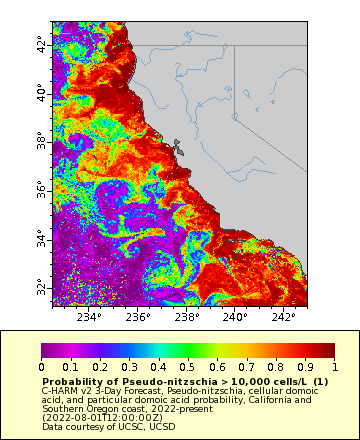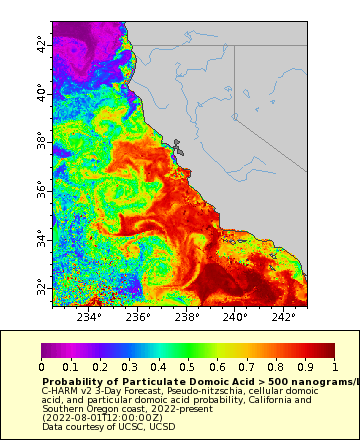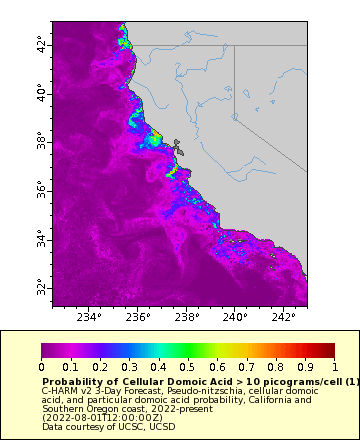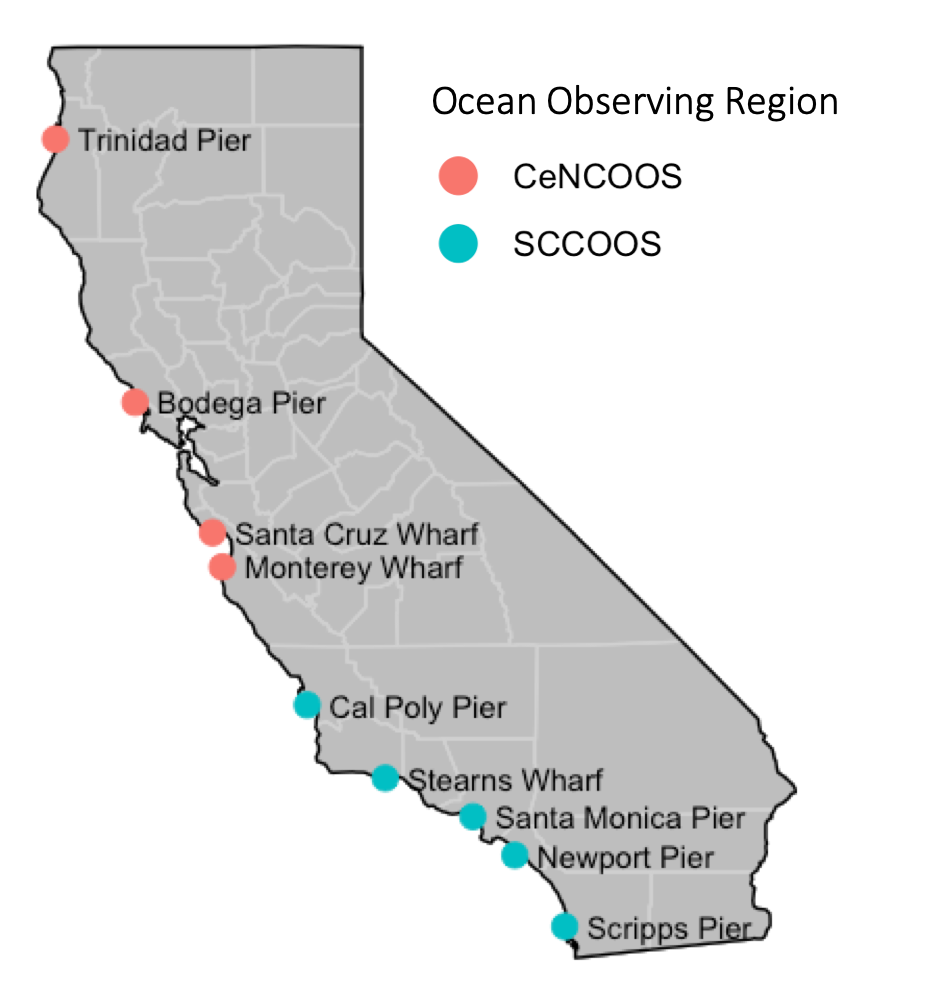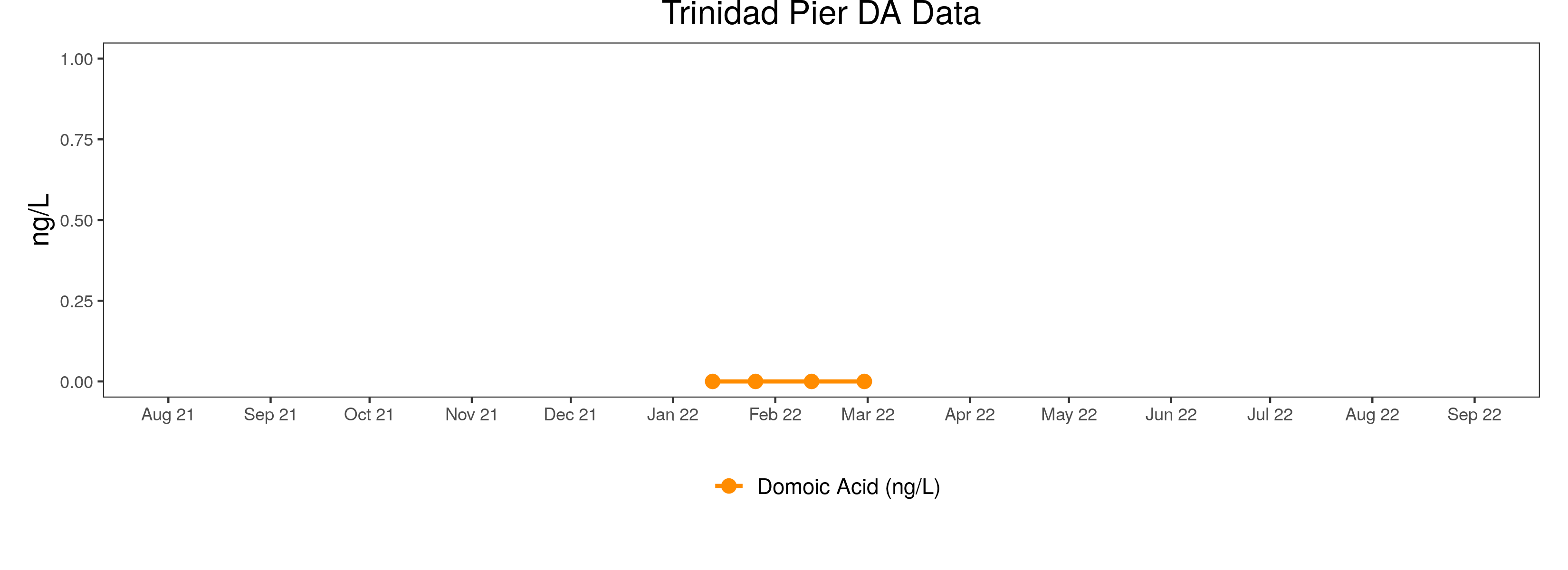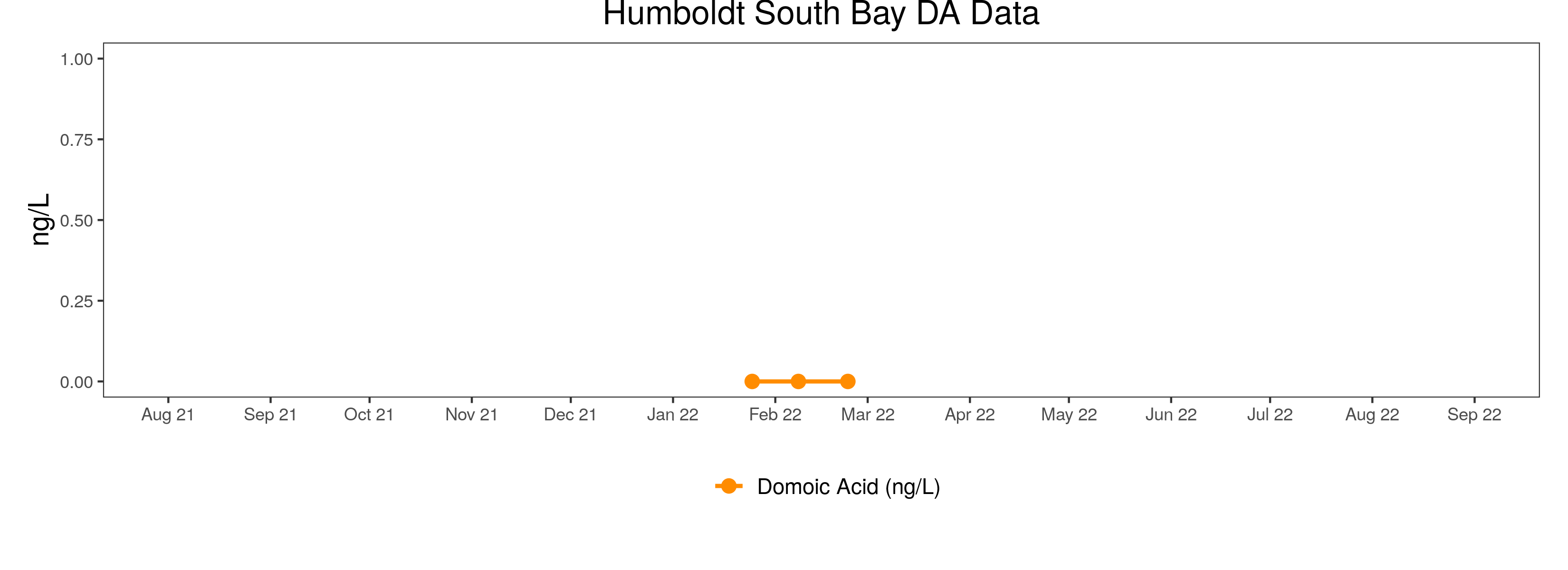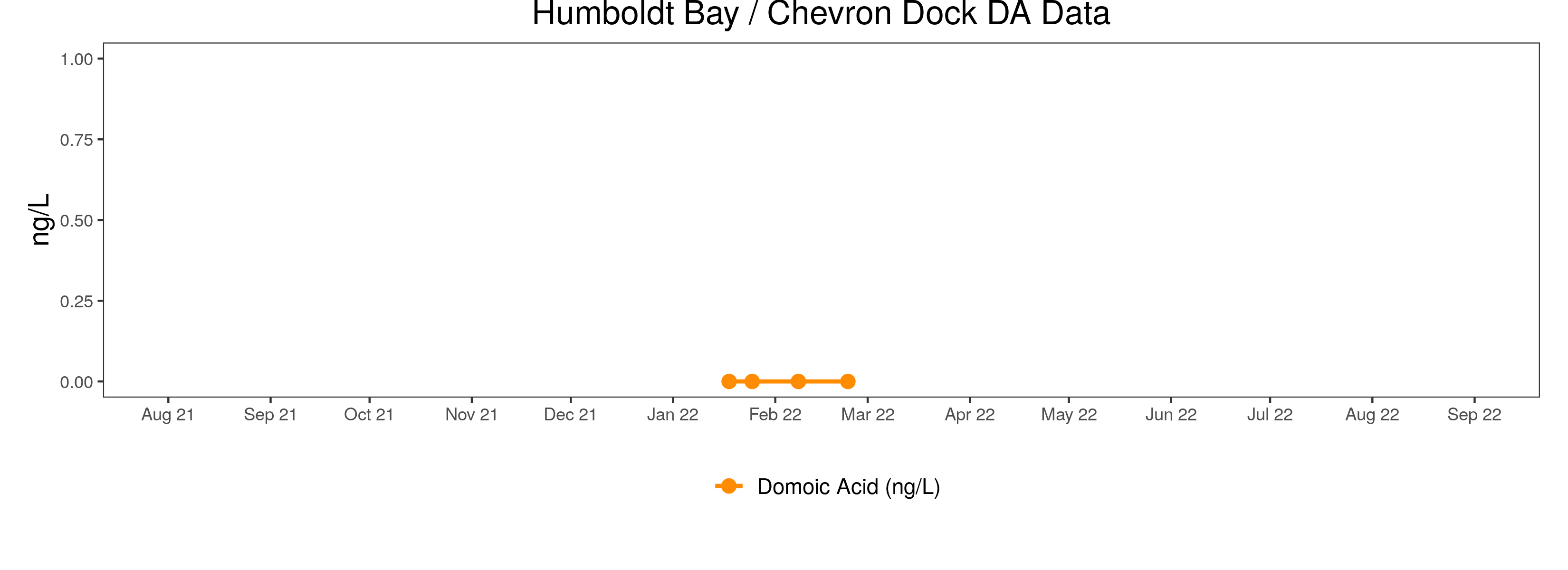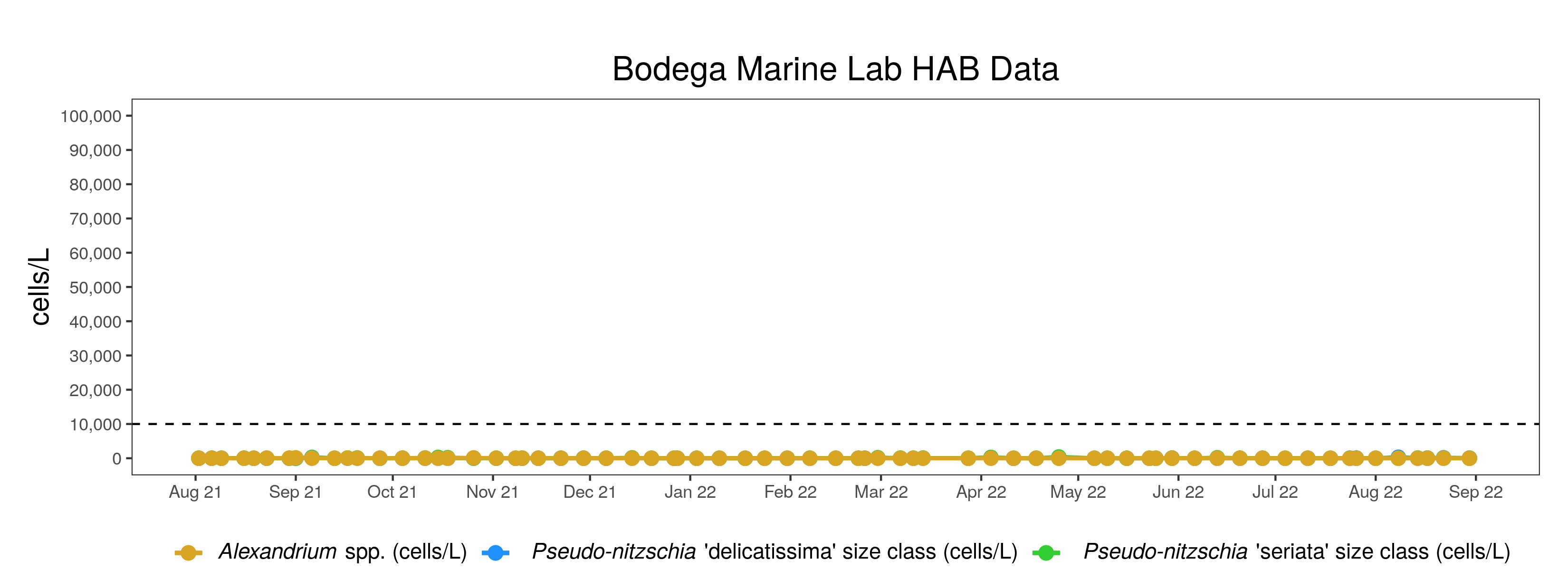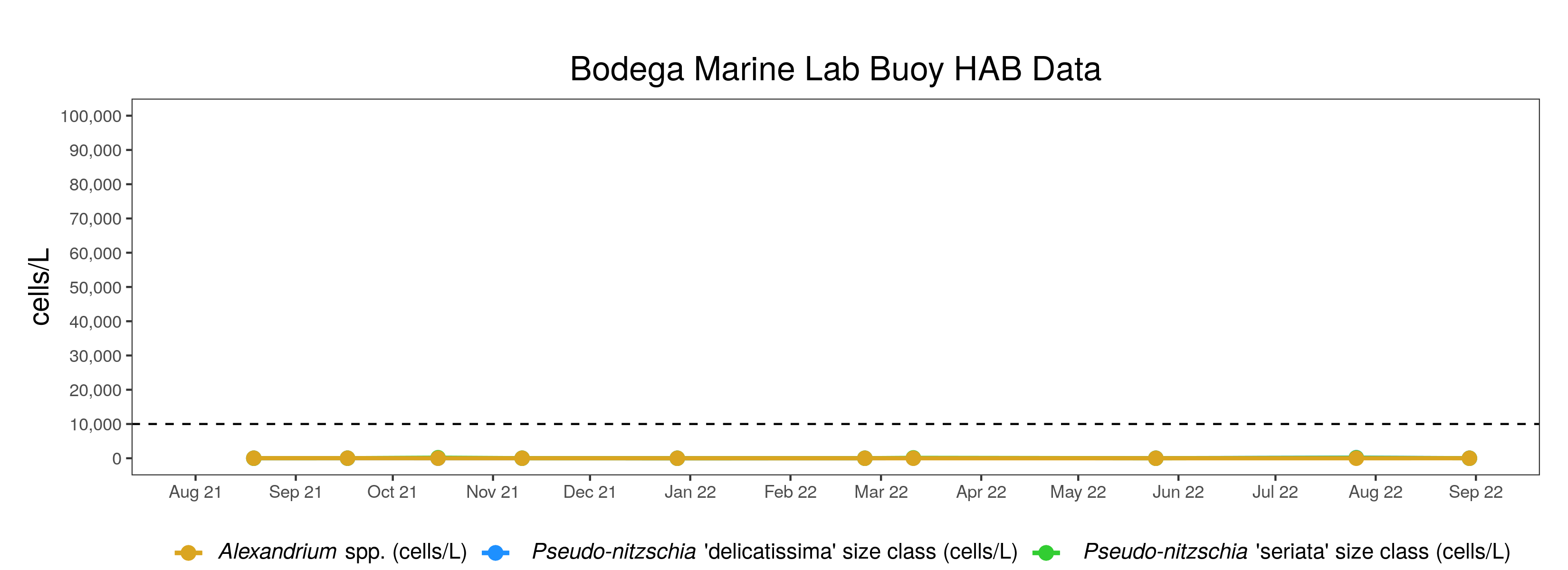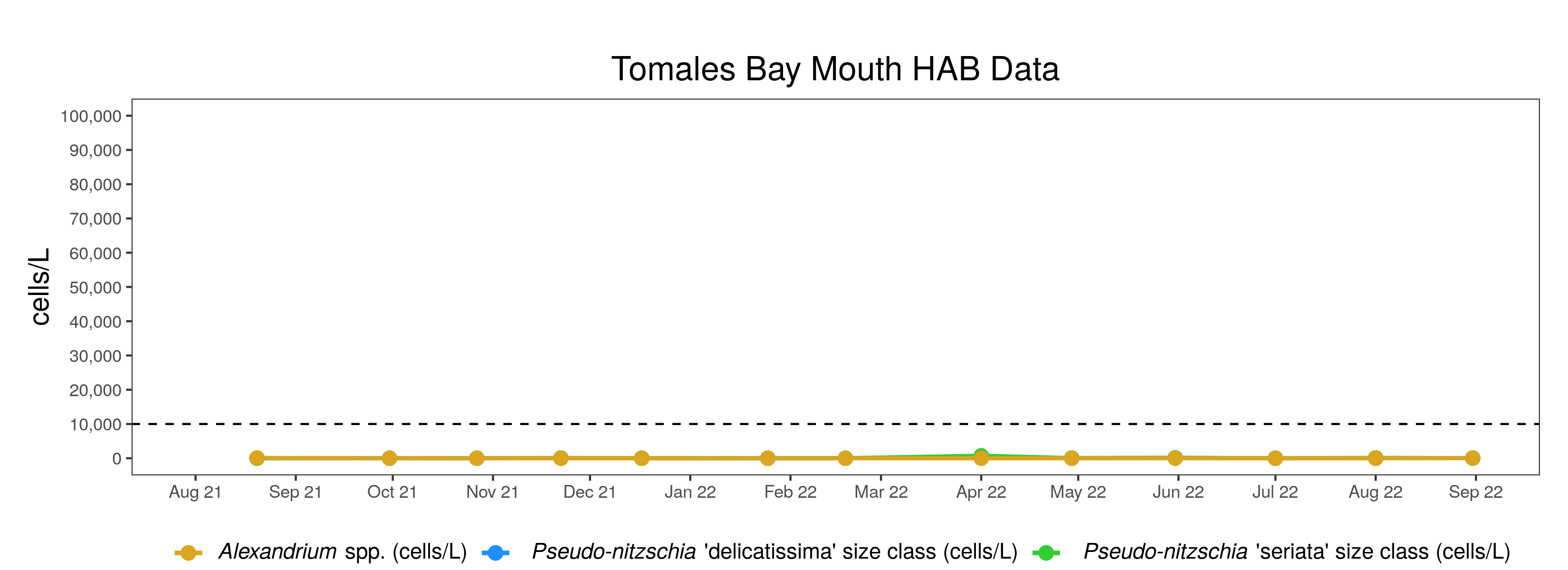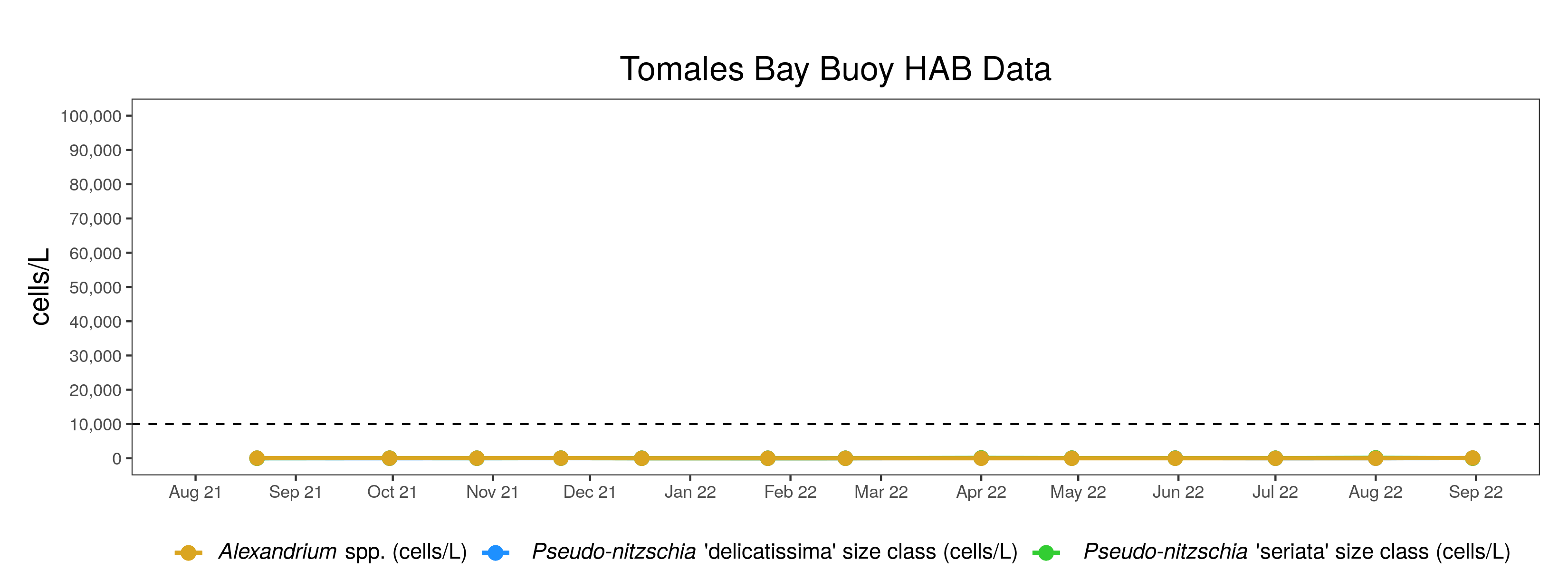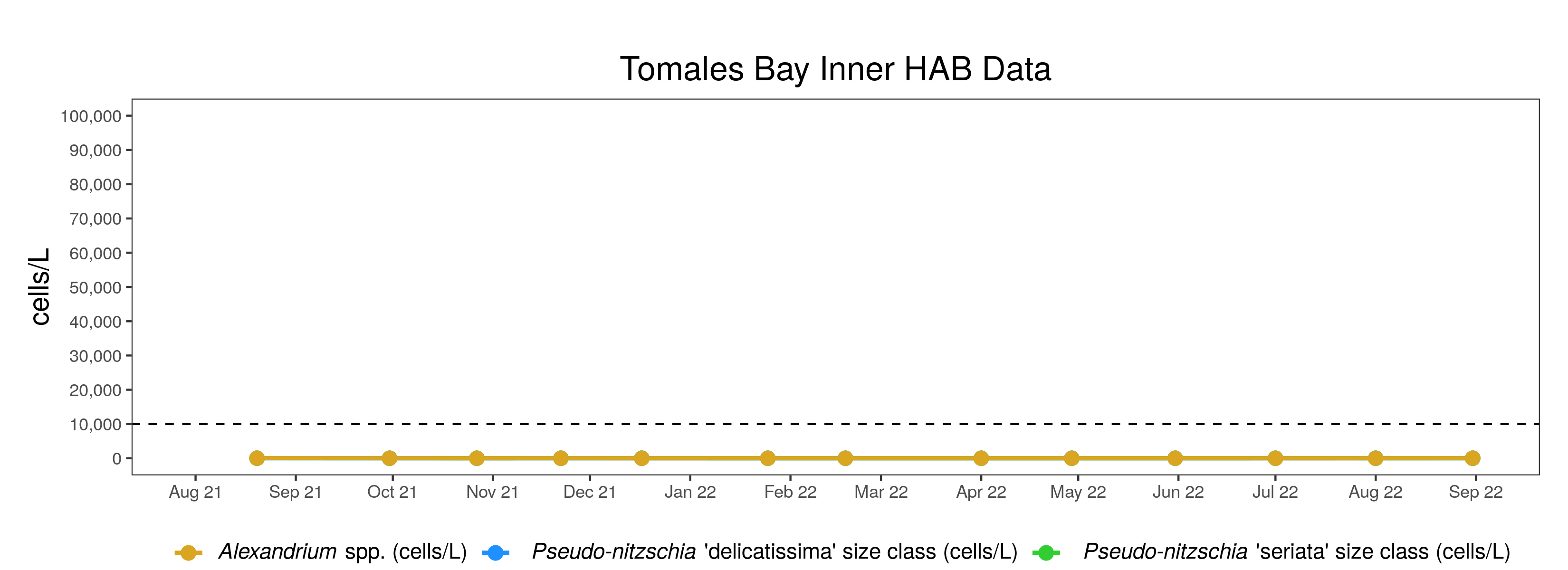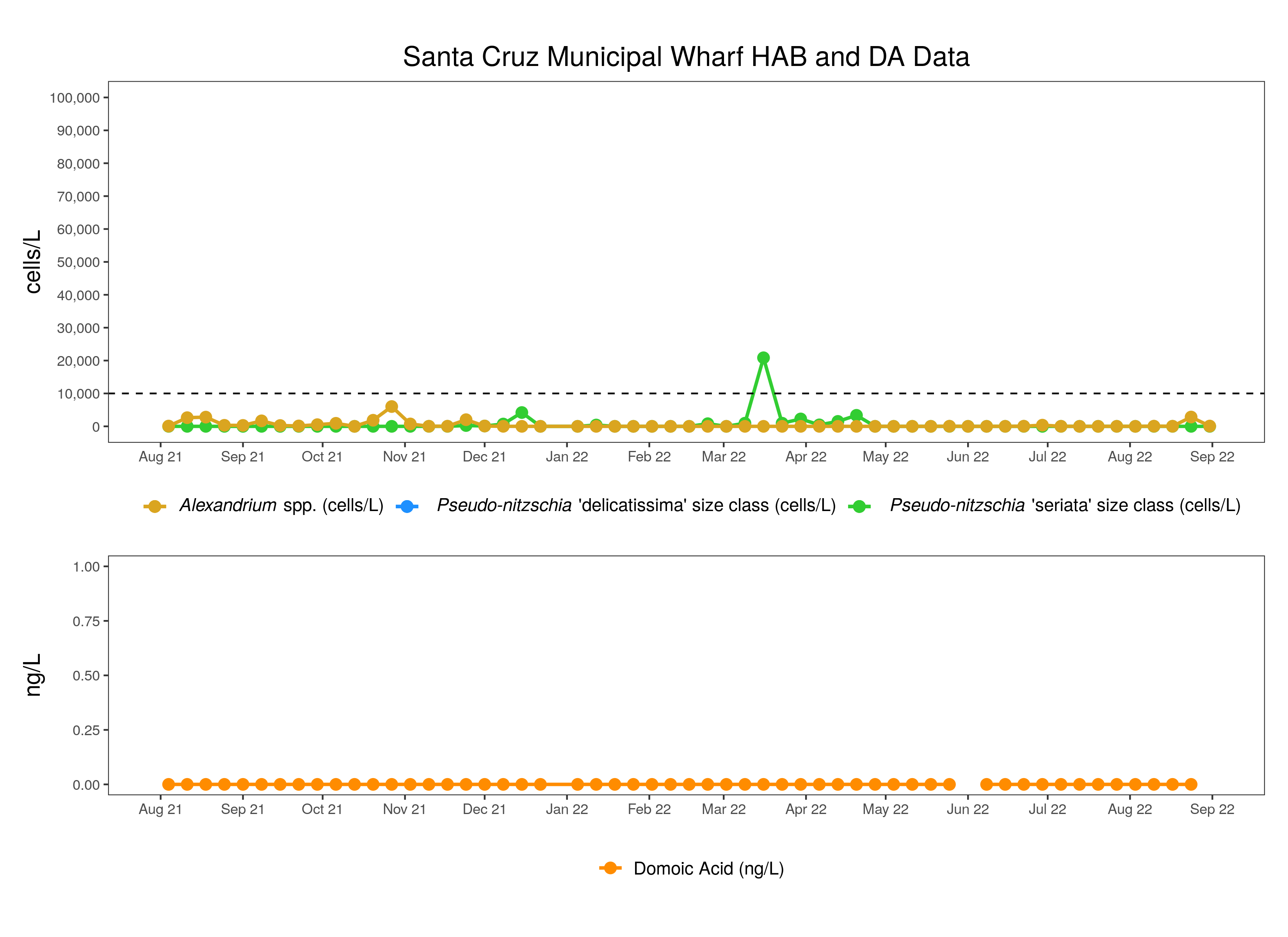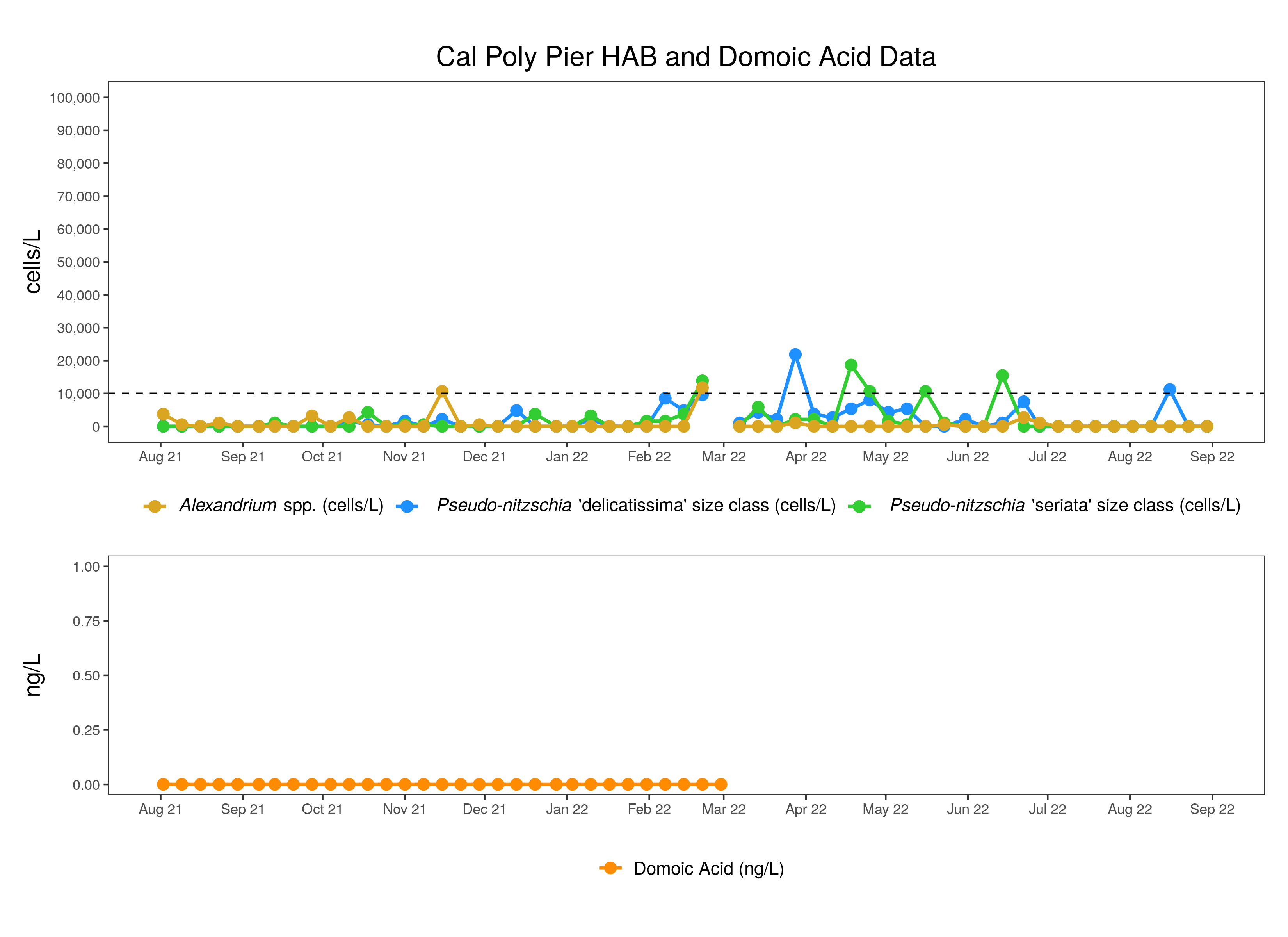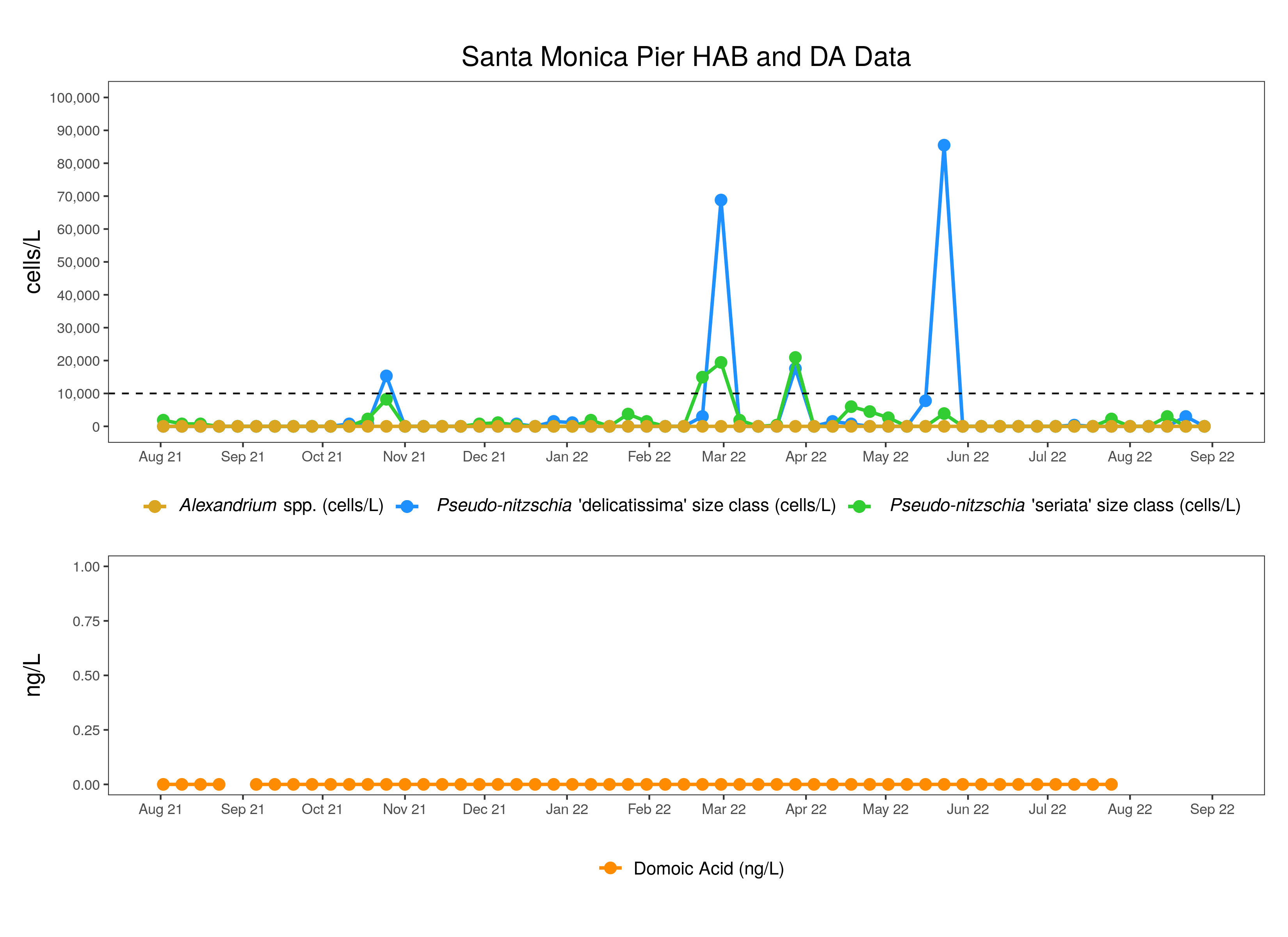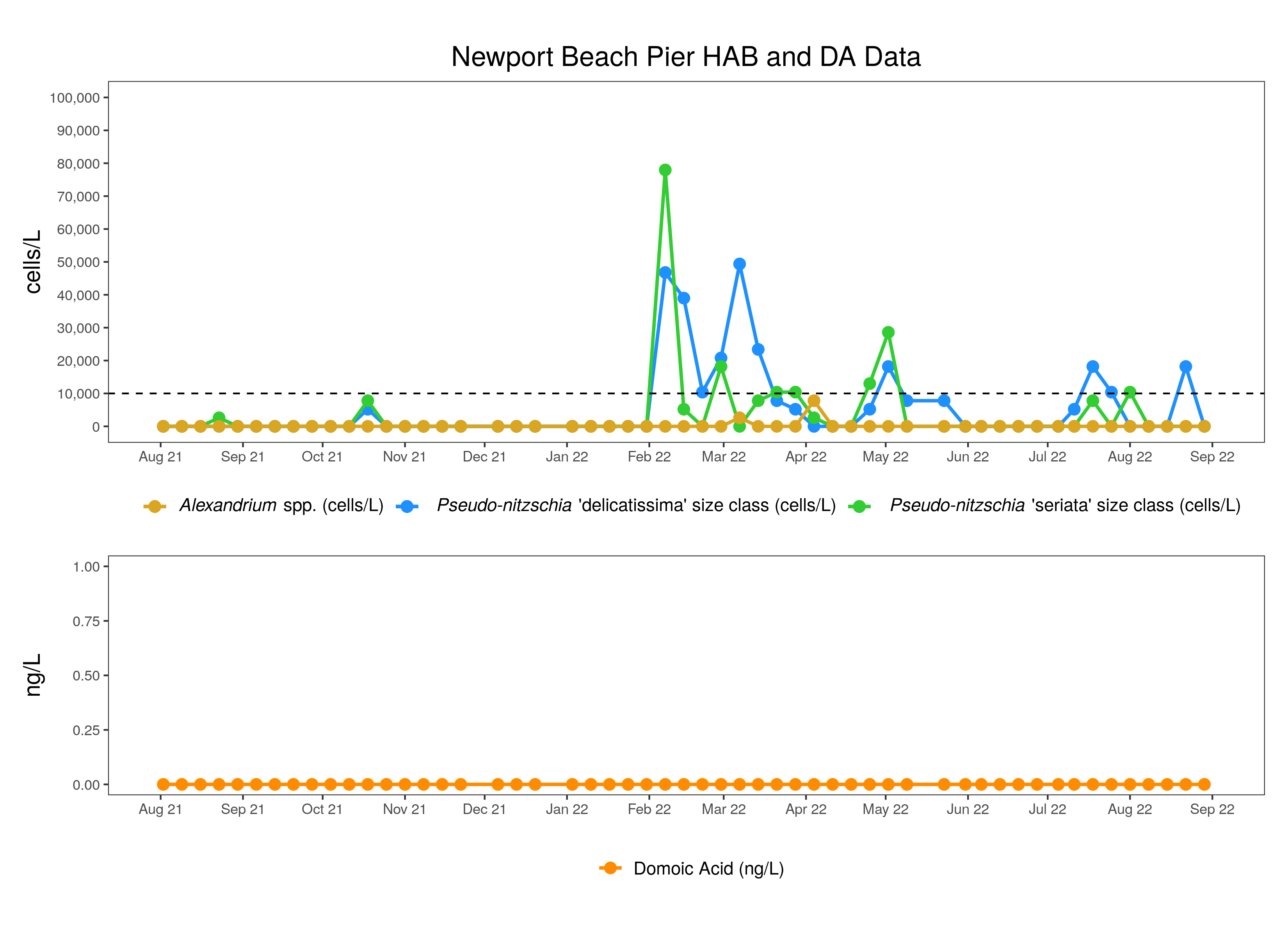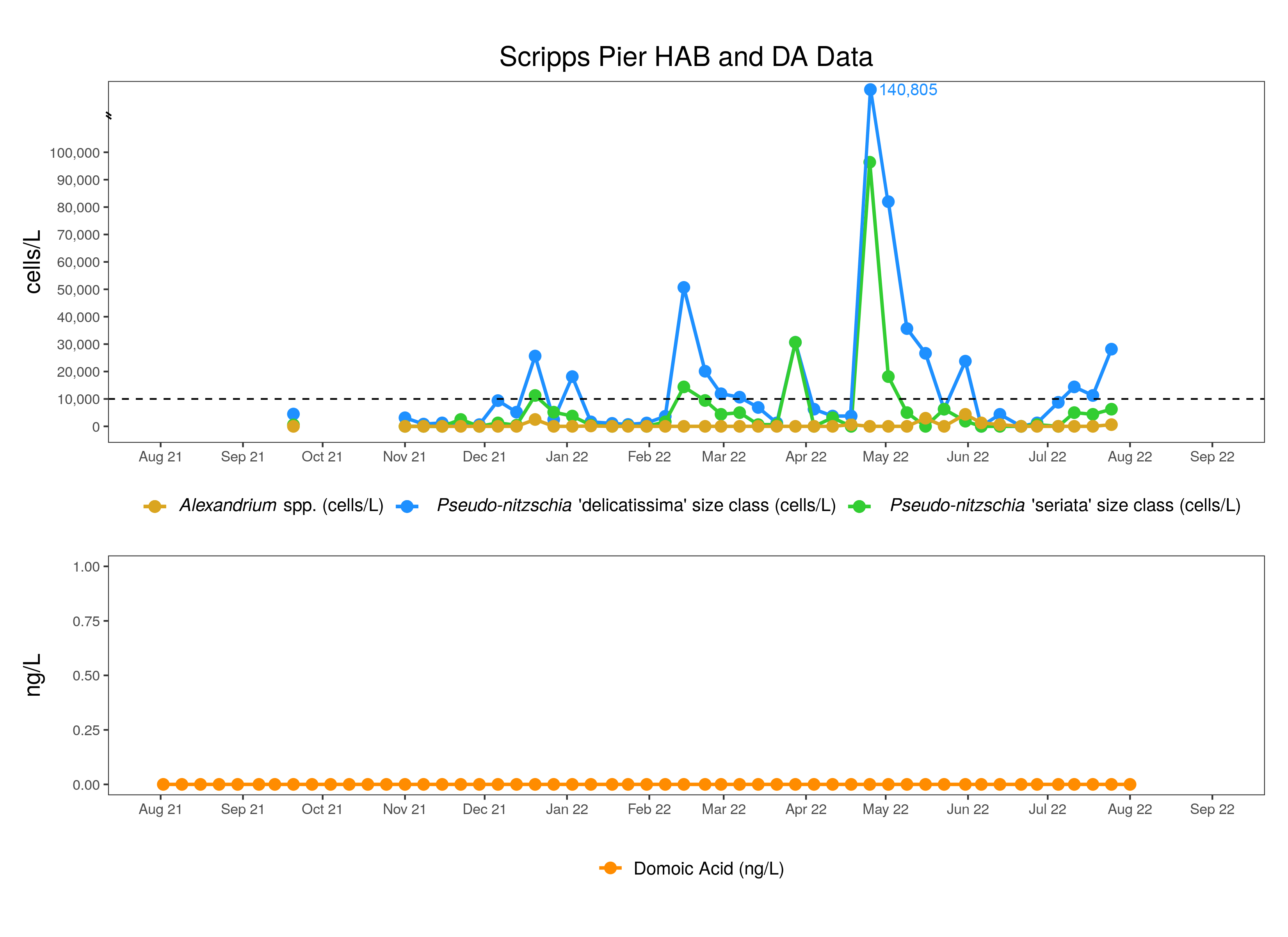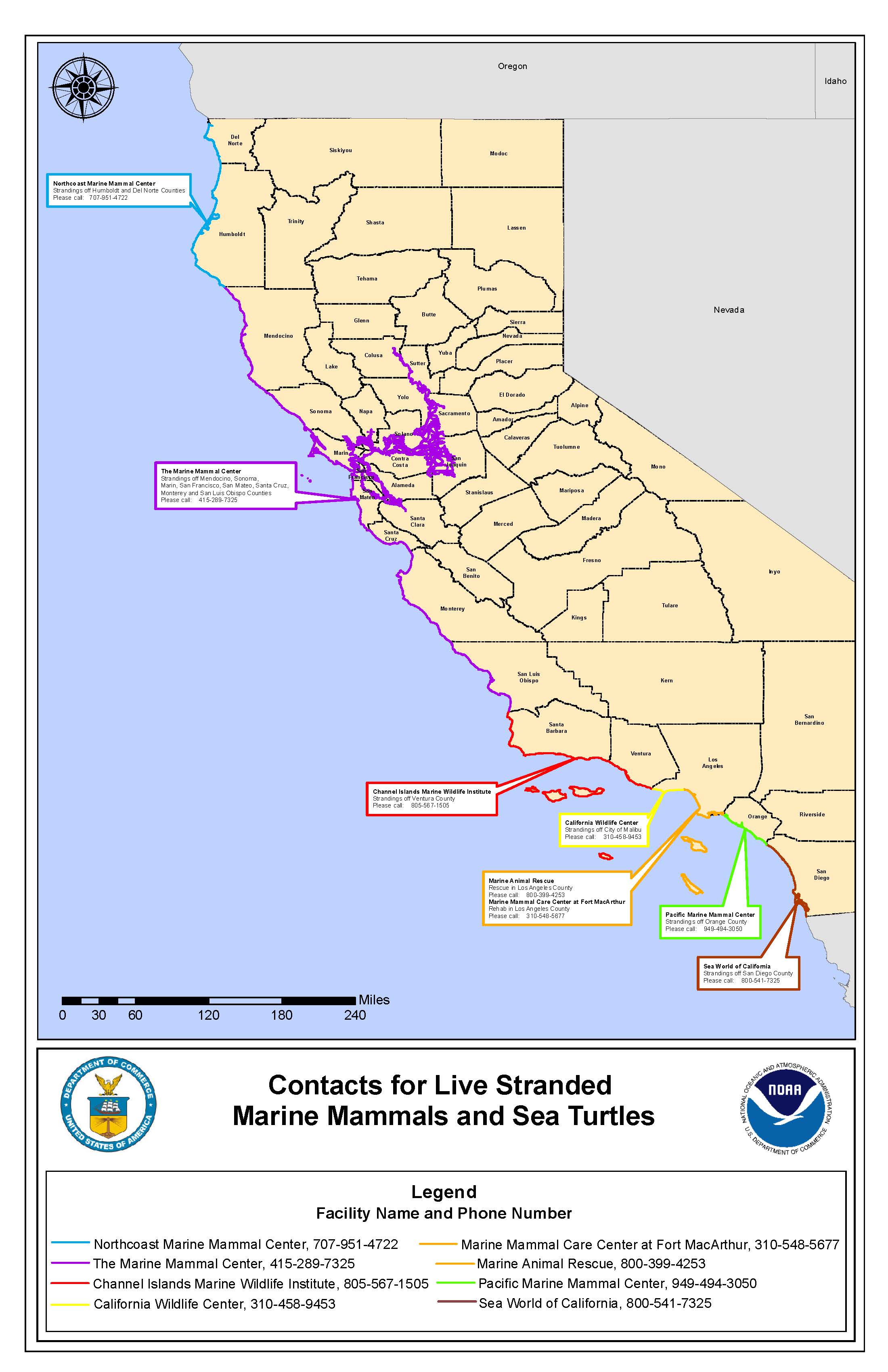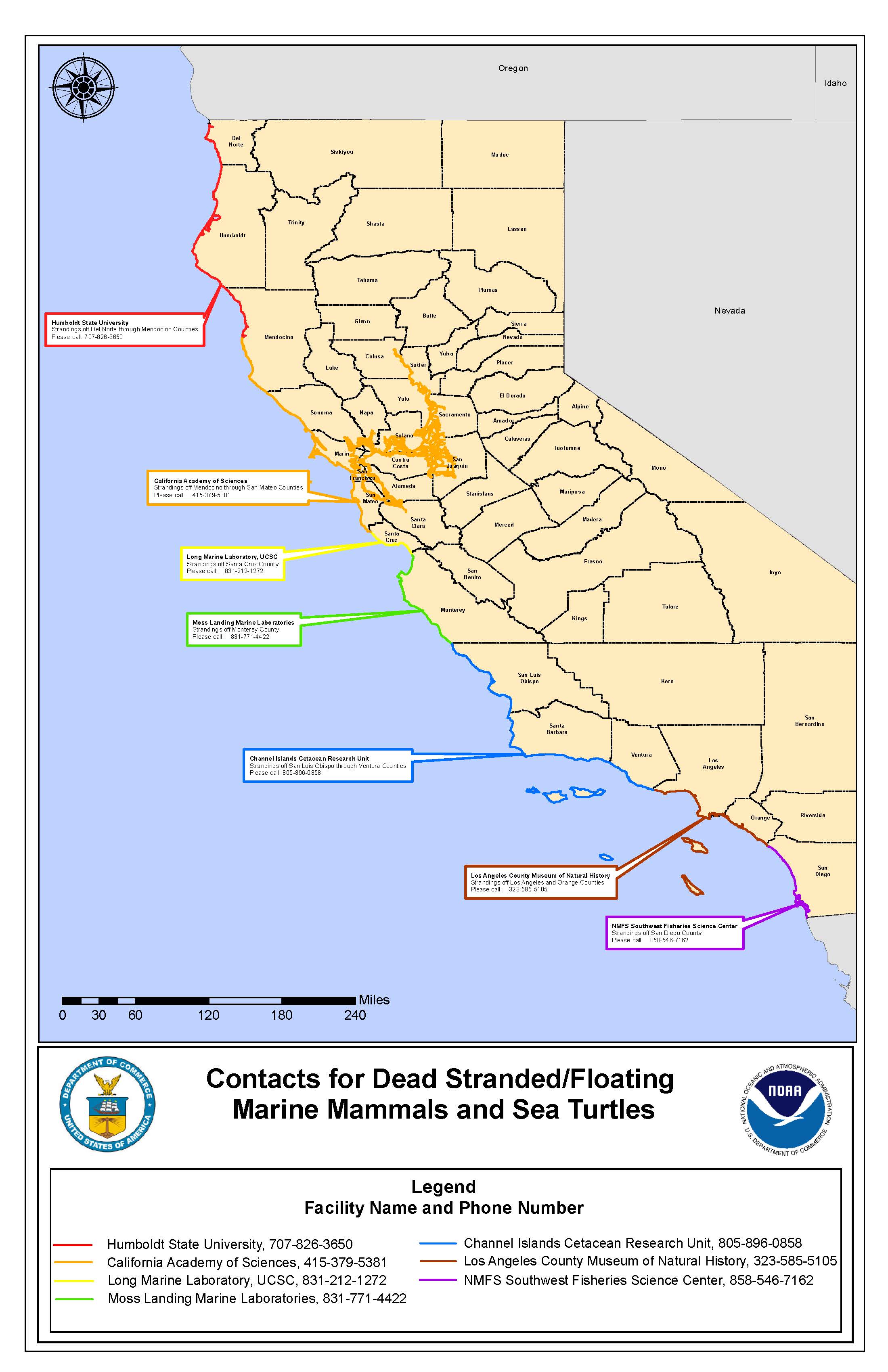AUGUST HIGHLIGHTS
*note: for the full suite of HAB taxa sampled weekly, see the SCCOOS and CeNCOOS HABMAP database and the Imaging FlowCytobot Dashboard.
Pseudo-nitzschia -
- C-HARM tells us where conditions are suitable for species of the diatom Pseudo-nitzschia spp. (all size classes) to grow well and where they might be more likely to produce the deadly neurotoxin, domoic acid (DA).
- C-HARM predictions for Pseudo-nitzschia spp. blooms in August kicked up a notch from July, indicating statewide potential for large blooms. The risk extended fairly high offshore for most of the state and turned into more of a tight coastal band of high probabilities along the South Coast.
- HABMAP pier sampling painted a different picture with fairly quiescent Pseudo-nitzschia spp. activity in the nearshore environment, as in July. While present at most sites, Pseudo-nitzschia only reached bloom levels at Newport Beach Pier and once at Cal Poly Pier. Both size classes approached the bloom threshold at Stearns Wharf in Santa Barbara. However, we know a sizable, or at least highly toxic bloom developed offshore in the Santa Barbara and Ventura area later in August. More information on this event will follow in the September Bulletin as well.
- Pseudo-nitzschia activity from CDPH coastal sampling, however, detected Pseudo-nitzschia 'seriata' as 'Abundant' in the Santa Barbara Channel at two sites - one nearshore (Naples) and one at the Santa Cruz Island (Scorpion Anchorage) in mid to late August, which is consistent with the domoic acid event that developed in August in Ventura and Santa Barbara and has extended well into September.
- The CA Imaging FlowCytobot Network images from the piers were intermittently available in August and did not detect a Pseudo-nitzschia bloom. However, an IFCB onboard the recent CalCOFI cruise did image high densities of Pseudo-nitzschia in offshore waters of the Santa Barbara Channel, corroborating an offshore theory to the bloom origin causing the DA event and ensuing marine mammal stranding event.
- C-HARM probabilities for particulate domoic acid (pDA) at the beginning of August suggested a lot of DA potential in central CA and large swaths of the Southern California Bight. In mid-August, this shifting to a much tighter bolus of high pDA potential in the southeast portion of the Santa Barbara Channel (Ventura County) and then spread to encompass the entire Santa Barbara Channel, followed by an increase in probabilities offshore of Pt. Conception, the central coast south of Monterey Bay, and into Southern California, primarily offshore.
- The pattern for C-HARM predictions of cellular domoic acid (cDA) probability diverged from that of pDA since there were no elevated probabilities in the Santa Barbara Channel region or further south throughout the month. The high risk for high levels of cDA was found in central CA and parts of the North Coast, closer to shore. This means that the cells in the central coast during the DA event that spread north and south in early September could have been more toxic on average than those in the Santa Barbara Channel or the rest of the Bight.
- Unfortunately, the results for DA from HABMAP sampling is still limited for August, with most analysis still pending, however, available data at Santa Cruz Wharf indicate that DA was below detection most of the month as it has been at that site for many years now.
- The DA event that began in mid to late August in Ventura and then Santa Barbara is on-going and so far totals over 400 animals stranded or recovered (many humanely euthanized at care centers). The number of stranded animals in August alone was quite high, and details are provided below in the this bulletin. The majority of animals presenting with DA toxicosis on beaches from central to southern California were adult females, with some notable exceptions, such as a Northern fur seal at CIMWI. C-HARM pDA predictions tracked the movement of stranded animals from mid- to late-August as the strandings began in Ventura, moved into the entire Santa Barbara Channel area and then moved to Orange County and a bit further south, as well as north to central CA where TMMC picked up many animals. Predictions of pDA extent matched stranding patterns well and indicted that this offshore bloom was only detectable by C-HARM since HABMAP did not detect the Pseudo-nitzschia bloom at pier sites. Offshore sampling is underway with partners at SCCWRP and Santa Barbara ChannelKeeper using NCCOS Harmful Algal Bloom Event Response program funds to SCCWRP and SCCOOS.
- Note that CDPH lifted the razor clam domoic acid health advisory on June 27th, but the annual quarantine on consuming recreational mussels is still in effect until October 15th.
Alexandrium -
- CDPH detected Alexandrium spp. at background "Present" levels at sampling sites throughout the state in August despite the fact that a Paralytic Shellfish Poisoning (PSP) advisory was issued for San Mateo county in central/northern California on September 2. Those sites are generally consistent with HABMAP sampling, which detected Alexandrium spp. at low levels at Tomales Bay, Santa Cruz Municipal Wharf, and Stearns Wharf multiple times in the month.
Summary written by Clarissa Anderson on Sep 29, 2022
Note that data for some stations are not shown because they are not yet recorded in the public HABMAP archive.
Differentiating Pseudo-nitzschia species by light microscopy is difficult. For this reason, Pseudo-nitzschia "seriata" does not refer to an actual species but rather the larger size class of Pseudo-nitzschia, which is generally a more toxigenic group of species. Alternatively, Pseudo-nitzschia "delicatissima" refers to the smaller size class that is generally non-toxigenic. The dashed line on the plots demarcates the 10,000 cells/L "bloom" threshold designated here for Pseudo-nitzschia populations only.
More information and data visualizations on the statewide HAB network and forecasting system can be found on the California HABMAP website and on the SCCOOS Harmful Algal Bloom page.
Six water samples were collected at Bodega Marine Lab in August. Pseudo-nitzschia "delicatissima" was detected five times (August 8, 14, 17, 22, 30), all below the bloom threshold. Pseudo-nitzschia "seriata" was detected four times (August 8, 14, 17, 22), also below the threshold. Alexandrium spp. were not detected. Domoic acid results are pending.
The Bodega Marine Lab shore station is supported by CeNCOOS PI John Largier.
One water sample was collected at Bodega Marine Lab Buoy in August. Pseudo-nitzschia "delicatissima" and Pseudo-nitzschia "seriata" were detected on August 30 below the threshold. Alexandrium spp. were also detected. Domoic acid results are pending.
The Bodega Marine Lab Buoy shore station is supported by CeNCOOS PI John Largier.
Two water samples were collected at Tomales Bay Mouth (T00) in August. Pseudo-nitzschia "delicatissima" and Pseudo-nitzschia "seriata" were detected each time (August 1, 31) below the bloom threshold. Alexandrium spp. were detected in the last sample only. Domoic acid results are pending.
The T00 shore station is supported by CeNCOOS.
Two water samples were collected at Tomales Bay Buoy in August. Pseudo-nitzschia "delicatissima" and Pseudo-nitzschia "seriata" were detected each time (August 1, 31) below the bloom threshold. Alexandrium spp. were detected in the last sample only. Domoic acid results are pending.
The Tomales Bay Buoy shore station is supported by CeNCOOS.
Two water samples were collected at Tomales Bay Inner (T16) in August. Pseudo-nitzschia "delicatissima" was detected each time (August 1, 31) below the bloom threshold. Pseudo-nitzschia "seriata" was detected once on August 1, also below the threshold. Alexandrium spp. were detected in the last sample only. Domoic acid results are pending.
The T16 shore station is supported by CeNCOOS.
Five water samples were collected at Santa Cruz Wharf in August. Molecular probes for toxigenic Pseudo-nitzschia in the "seriata" class are conducted for this site, and was not detected. Alexandrium spp. were detected four times (August 10, 17, 24, 31). Domoic acid was not detected, however the last sample is pending.
The Santa Cruz Wharf shore station is supported by CeNCOOS PI Raphael Kudela at UCSC
Five water samples were collected at Cal Poly Pier in August. Pseudo-nitzschia "delicatissima" was detected once on August 16, above the bloom threshold. Pseudo-nitzschia "seriata" and Alexandrium spp. were not detected. Domoic acid results are pending.
Cal Poly Pier shore station is supported by SCCOOS and PI Ally Pasulka at Cal Poly.
Four water samples were collected at Stearns Wharf in August. Pseudo-nitzschia "delicatissima" was detected once (August 10) below the bloom threshold. Pseudo-nitzschia "seriata" was detected twice (August 3, 10), also below the bloom threshold. Alexandrium spp. were detected twice (August 24, 29). Domoic acid results are pending.
Stearns Wharf is supported by SCCOOS and PIs Mark Brzezinski and Libe Washburn at UCSB.
Five water samples were collected at Santa Monica Pier in August. Pseudo-nitzschia "delicatissima" was detected once on August 22, below the threshold. Pseudo-nitzschia "seriata" was also detected once on August 15 below the threshold. Alexandrium spp. were not detected and domoic acid results are pending.
The Santa Monica Pier shore station is supported by SCCOOS and PI Rebecca Shipe at UCLA.
Five water samples were collected at Newport Beach Pier in August. Pseudo-nitzschia "delicatissima" was detected once on August 22 above the threshold. Pseudo-nitzschia "seriata" was also detected once (August 1) above the threshold. Alexandrium spp. and domoic acid were not detected.
Newport Beach Pier is supported by SCCOOS and PI David Caron at USC.
CDPH observations for Pseudo-nitzschia "seriata" and Alexandrium spp.
View the interactive map and data table of California Department of Public Health (CDPH) data from January 2019 to present, developed by SCCOOS, below. Or, view CDPH Toxic Phytoplankton Observations Map with layers of Pseudo-nitzschia and Alexandrium spp. as well as other phytoplankton species observations (in the pop-up windows).
Data are provided by the Environmental Management Branch of the CDPH. Please note, starting in July 2019, CDPH moved to only reporting Pseudo-nitzschia of the seriata complex and not all Pseudo-nitzschia spp. as previously provided.
Please email CDPH at Susan.Paulukonis@cdph.ca.gov for any potential marine HAB-related illness in humans.
From August 1-30 2022, water samples were collected by volunteers and sent to the California Department of Public Health (CDPH) for analysis.
Pseudo-nitzchia "seriata" group was detected in 52 of the 101 samples:
Pseudo-nitzschia "seriata" was detected at "Abundant" density levels on 2 occasions:
- 2022-08-12 58% Santa Barbara Ch., Naples Pt
- 2022-08-23 66.5% Santa Cruz Is., Scorpion Anch.
Pseudo-nitzschia "seriata" was detected at "Common" density levels on 7 occasions:
- 2022-08-05 20% Port San Luis, Diablo Cove
- 2022-08-10 25% Goleta Pier
- 2022-08-12 10% Monterey, Stillwater Cove
- 2022-08-14 40% Pillar Point Harbor
- 2022-08-17 15% Tiburon, Elephant Rock Pier
- 2022-08-21 25% Tomales Bay, Lease #M430-15
- 2022-08-28 25% Pillar Point Harbor
Pseudo-nitzschia "seriata" was detected at "Present" density levels on 24 occasions:
- 2022-08-01 3% Drakes Bay, Chimney Rock LBS
- 2022-08-02 4% Pacifica Pier
- 2022-08-03 4% Monterey, Stillwater Cove
- 2022-08-06 4% Trinidad Pier
- 2022-08-08 2% Pacifica Pier
- 2022-08-08 7% Tomales Bay, Lease #M430-15
- 2022-08-08 7% Tomales Bay, Lease #M430-15
- 2022-08-10 5% Port San Luis, Diablo Cove
- 2022-08-12 8% Sea Ranch
- 2022-08-15 1% Malibu Pier
- 2022-08-15 1% La Jolla, Scripps Pier
- 2022-08-15 7% Pacifica Pier
- 2022-08-15 8% Tomales Bay, Lease #M430-15
- 2022-08-16 4% Mendocino, Noyo Harbor
- 2022-08-16 5% Pillar Point Harbor
- 2022-08-16 9% San Francisco, Presidio Pier
- 2022-08-17 6% Bodega Harbor, USCG Dock
- 2022-08-17 9% Goleta Pier
- 2022-08-18 1% Port San Luis, Diablo Cove
- 2022-08-18 2% Point Richmond, Ferry Point
- 2022-08-20 4% San Simeon Pier
- 2022-08-21 8% Pacifica Pier
- 2022-08-22 1% San Francisco Marina
- 2022-08-29 5% Humboldt Bay, Indian Is. Ch.
Pseudo-nitzschia "seriata" was detected at "Rare" density levels on 19 occasions:
- 2022-08-01 0.5% Tomales Bay, Lease #M430-15
- 2022-08-01 0.5% Morro Bay, Boat Launch
- 2022-08-03 0.5% Mendocino, Noyo Harbor
- 2022-08-03 0.5% Goleta Pier
- 2022-08-05 0.5% San Simeon Pier
- 2022-08-08 0.5% Humboldt Bay, Indian Is. Ch.
- 2022-08-15 0.5% Morro Bay, Boat Launch
- 2022-08-16 0.5% Drakes Bay, Chimney Rock LBS
- 2022-08-17 0.5% Santa Monica Pier
- 2022-08-19 0.5% Bolsa Chica
- 2022-08-22 0.5% Sausalito Yacht Club
- 2022-08-22 0.5% Humboldt Bay, Indian Is. Ch.
- 2022-08-23 0.5% Mendocino, Noyo Harbor
- 2022-08-25 0.5% South SF, Oyster Point
- 2022-08-25 0.5% Imperial Beach Pier
- 2022-08-26 0.5% San Simeon Pier
- 2022-08-28 0.5% Pacifica Pier
- 2022-08-29 0.5% Wilson Creek
- 2022-08-29 0.5% Tomales Bay, Lease #M430-15
Alexandrium spp. were detected in 19 of the 101 samples:
Alexandrium spp. were not detected at "Common" density levels.
Alexandrium spp. were detected at "Present" density levels on 8 occasions:
- 2022-08-04 1% Morro Bay, North T-Pier
- 2022-08-08 2% La Jolla, Scripps Pier
- 2022-08-10 4% Richmond, Marina Bay Harbor
- 2022-08-17 1% Tiburon, Ferry Terminal
- 2022-08-17 1% Sausilito, Marina Plaza Harbor
- 2022-08-22 7% Sausalito Yacht Club
- 2022-08-29 5% Tomales Bay, Lease #M430-15
- 2022-08-29 7% Drakes Bay, Chimney Rock LBS
Alexandrium spp. were detected at "Rare" density levels on 11 occasions:
- 2022-08-01 0.5% La Jolla, Scripps Pier
- 2022-08-01 0.5% Tomales Bay, Lease #M430-15
- 2022-08-09 0.5% Imperial Beach Pier
- 2022-08-15 0.5% Morro Bay, Boat Launch
- 2022-08-15 0.5% Pacifica Pier
- 2022-08-18 0.5% Berkeley Marina
- 2022-08-18 0.5% Point Richmond, Ferry Point
- 2022-08-21 0.5% Pacifica Pier
- 2022-08-22 0.5% San Francisco Marina
- 2022-08-24 0.5% Santa Cruz Wharf
- 2022-08-28 0.5% Pacifica Pier
CDPH and OEHHA Health Advisories
September 2, 2022 – The California Department of Public Health (CDPH) is advising consumers not to eat sport-harvested mussels, clams, or whole scallops from San Mateo County.
June 27. The California Department of Public Health (CDPH) has lifted the shellfish safety notification related to sport-harvested razor clams in Del Norte County.
April 26. The California Department of Public Health (CDPH) today announced the annual quarantine of sport-harvested mussels gathered along the California coast beginning May 1.
April 2. The California Department of Public Health (CDPH) warned consumers today not to eat raw oysters from British Columbia, Canada because they may be linked to an outbreak of norovirus illnesses in California. Canadian officials continue to investigate the source of norovirus illnesses and have closed multiple growing regions in British Columbia for sanitary contamination.
December 16. The California Department of Public Health (CDPH) is advising consumers not to eat sport-harvested razor clams from Del Norte County due to dangerous levels of naturally occurring domoic acid, also referred to as Amnesic Shellfish Poisoning, being detected.
November 29. The California Department of Public Health (CDPH) has lifted the shellfish safety notification for Dungeness crab caught in state waters from the Sonoma/Mendocino County Line (38° 46.125' N. Latitude) to Point Reyes (38° N. Latitude) in Marin County.
November 5. Due to the detection of elevated levels of domoic acid, a naturally occurring toxin, the California Department of Public Health (CDPH) is warning consumers not to eat the viscera (internal organs) of Dungeness crab caught in coastal waters.
For the latest closures and updates, please visit the CDPH Health Advisories page as a central location of information related to CDPH health advisories. Also available is a map showing the current CDPH Recreational Bivalve Shellfish Advisories (see below).
The HAB-related illness workgroup has developed a new webpage for marine HAB-related illness tracking work (https://oehha.ca.gov/fish/general-info/marine-harmful-algal-bloom-hab-related-illness-tracking).
A network of Imaging FlowCytobots (IFCBs) continuously photographs particles, such as plankton, in the water. Using machine learning, plankton species can be automatically identified. This will help improve the ability to detect and respond to Harmful Algal Blooms, including the ability to assess conditions that may lead to toxin production or blooms of toxin-producing algae.
Additional images and data are available on the IFCB dashboard.
Pseudo-nitzschia was observed across many locations in CA in August. This image was taken in the Santa Barbara Channel during a Plumes and Blooms cruise.
Domoic acid (DA) is a potent neurotoxin produced by some diatom species of the genus Pseudo-nitzschia. Species exposed to DA can result in seizures, epilepsy, cardiomyopathy, and death depending upon the ingested dose. DA toxicosis commonly occurs in California Sea Lions (Zalophus californianus), presumably due to a combination of foraging behavior and seasonal movements. The Marine Mammal Center (TMMC), Channel Islands Marine Wildlife Institute (CIMWI), California Wildlife Center (CWC), Marine Mammal Care Center Los Angeles (MMCC-LA), Marine Animal Rescue (MAR), the Pacific Marine Mammal Center (PMMC), SeaWorld, and Southwest Fisheries Science Center (SWFSC) act like an emergency room by working to rescue and rehabilitate sick and injured marine mammals, seabirds, and sea turtles.
SeaWorld and CWC did not record any strandings due to suspected domoic acid in August 2022. Results from SWFSC and MAR are pending.
There were numerous DA-related strandings reported in August and September. Between August 15 and September 20, CIMWI reported 262 probable DA cases in California Sea Lions in Ventura and Santa Barbara Counties. TMMC had 14 suspected cases, MMCCLA had 18 cases (12 in August and 6 early September), and 2 at PMMC. Note that some details are missing.
August strandings due to suspected DA toxicosis occurred in the following counties:
- Monterey (TMMC)
- August 27 - Adult, female, California Sea Lion
- San Luis Obispo (TMMC)
- August 26 - Adult, female, California Sea Lion
- August 27 - 3 Adult, female, California Sea Lions
- August 28 - Adult, female, California Sea Lion
- August 29 - 2 Adult, female, California Sea Lions
- August 30 - 3 Adult, female, California Sea Lions
- August 31 - 3 Adult, female, California Sea Lions
- Santa Barbara (CIMWI)
- 45 California Sea Lions in August
- Ventura (CIMWI)
- 119 California Sea Lions in August
- Los Angeles (MMCCLA)
- August 16 - Adult, female, California Sea Lion
- August 18 - Adult, female, California Sea Lion
- August 20 - Adult, female, California Sea Lion
- August 21 - Adult, female, California Sea Lion
- August 24 - subadult, female, California Sea Lion
- August 26 - 1 Adult and 1 subadult, female, California Sea Lions
- August 27 - Adult, female, California Sea Lion
- August 28 - 2 Adult, female, California Sea Lions
- August 30 - 2 subadult, female, California Sea Lions
- Orange County (PMMC)
- August 20 - Adult, female, California Sea Lion
- August 28 - Adult, female, California Sea Lion

